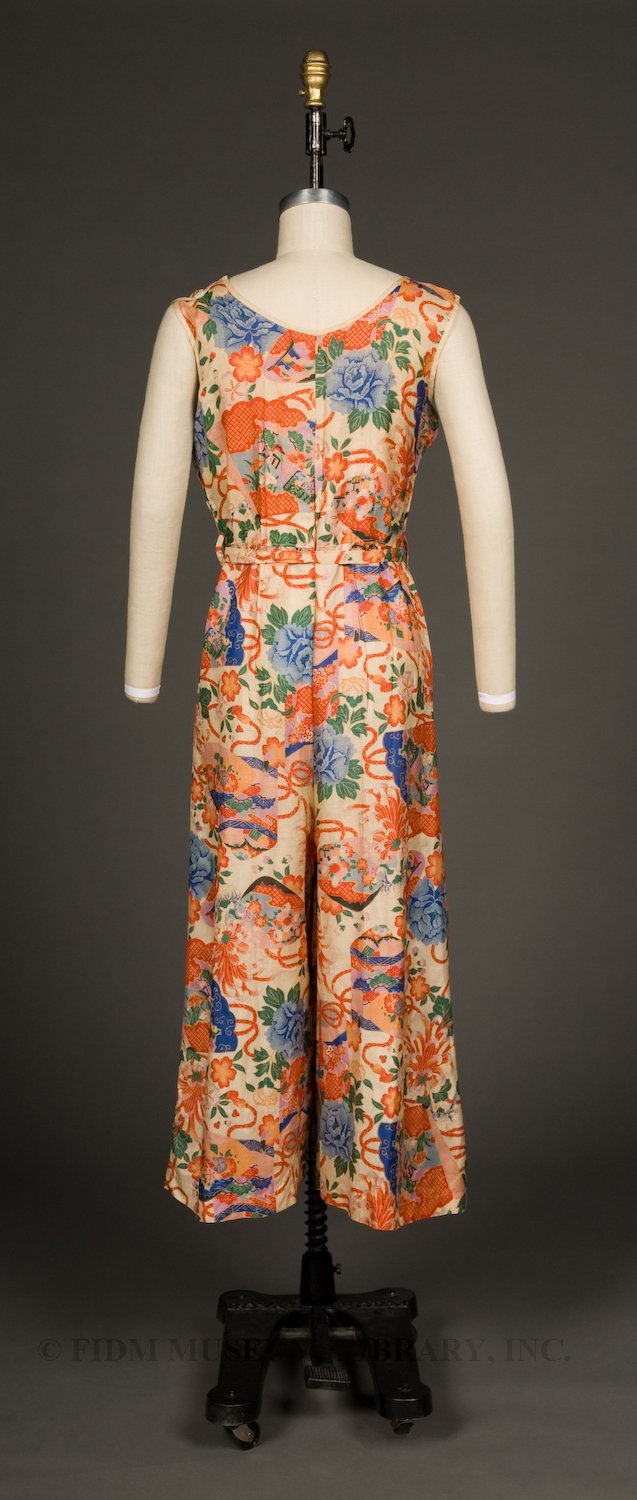Lounge pajamas, c. 1935
During the 1920s, pajamas moved from bedroom to beach. Though pajama style pants were suggested by Paul Poiret as avant garde dress during the teens, pajamas were worn primarily as sleepwear until the 1920s. Sometime during the mid-to-late 1920s, pajamas appeared outside the bedroom as swimsuit cover-ups on the beaches of the French Riviera. Beach pajamas soon became a double-duty garment for the relaxed resort lifestyle, one that navigated easily from beach to cocktail party. In 1931, Vogue magazine declared, "A woman may and does wear pajamas to quite formal dinners in her own house, to other people's dinners in town and country if you know them well and the more iconoclastic members of the female sex even wear them to the theatre."1 For women who aspired to a resort lifestyle but didn't have the necessary means or leisure, pajamas could be worn for entertaining or relaxing at home. Worn in these situations, beach pajamas became lounge pajamas or sometimes "lounjamas."2 During the 1920s, beach or lounge pajamas were usually two-piece ensembles accompanied by a matching jacket. By the 1930s, one-piece, jumpsuit-style pajamas had emerged. These one-piece lounge pajamas from the FIDM Museum collection are shaped with a self-fabric sash and fasten with a 3-button closure on the left side. Like menswear of the same period, these lounge pajamas feature a wide leg.
 Lounge pajamas c. 1935 Gift of the Manlove Family 2006.870.1AB
Lounge pajamas c. 1935 Gift of the Manlove Family 2006.870.1AB
According to period fashion illustrations, beach/lounge pajamas were similar in appearance to sleeping pajamas. This visual similarity must have led to some confusion. A 1931 New York Times article suggested using caution when purchasing beach or lounging pajamas, as anything "that faintly suggests the boudoir is taboo."3 Lace or silk satin indicated nighttime pajamas, while a more rustic fabric like silk shantung, linen or cotton was appropriate for beach and lounging pajamas. As lounging and beach pajamas became widely popular in the 1930s, lower priced versions were available in rayon. Though pajamas were available in a tremendous variety of colors and patterns, textile patterns that borrowed freely from China and Japan were especially popular. The lightweight, printed silk textile used in the FIDM Museum beach pajamas is a typical example.
The emergence of garments geared specifically for the resort lifestyle led to a new category of clothing: resort wear. Alongside fall/winter and spring/summer, resort became a fifth "season" for which garments were designed. Not an actual season, resort wear suggested a particular state of mind: relaxed, chic and affluent. Resort wear was, and still is, loosely defined, characterized largely by its bright colors, patterns and suitability for temperate climates. By definition, resort wear is closely related to vacationing, usually in close proximity to water. Because of its association with a lifestyle, rather than a season, resort wear is a firmly aspirational category of dress. Even if worn out of its intended context, resort wear conjures images of beaches, sun and sand.
1 "Pyjamas-When are they worn?" Vogue 1 June 1931: 71. 2 A term coined by Bullock's department store in advertising copy. 3 "To Be Seen On Southern Beaches." New York Times 1 Dec. 1929: 169.
